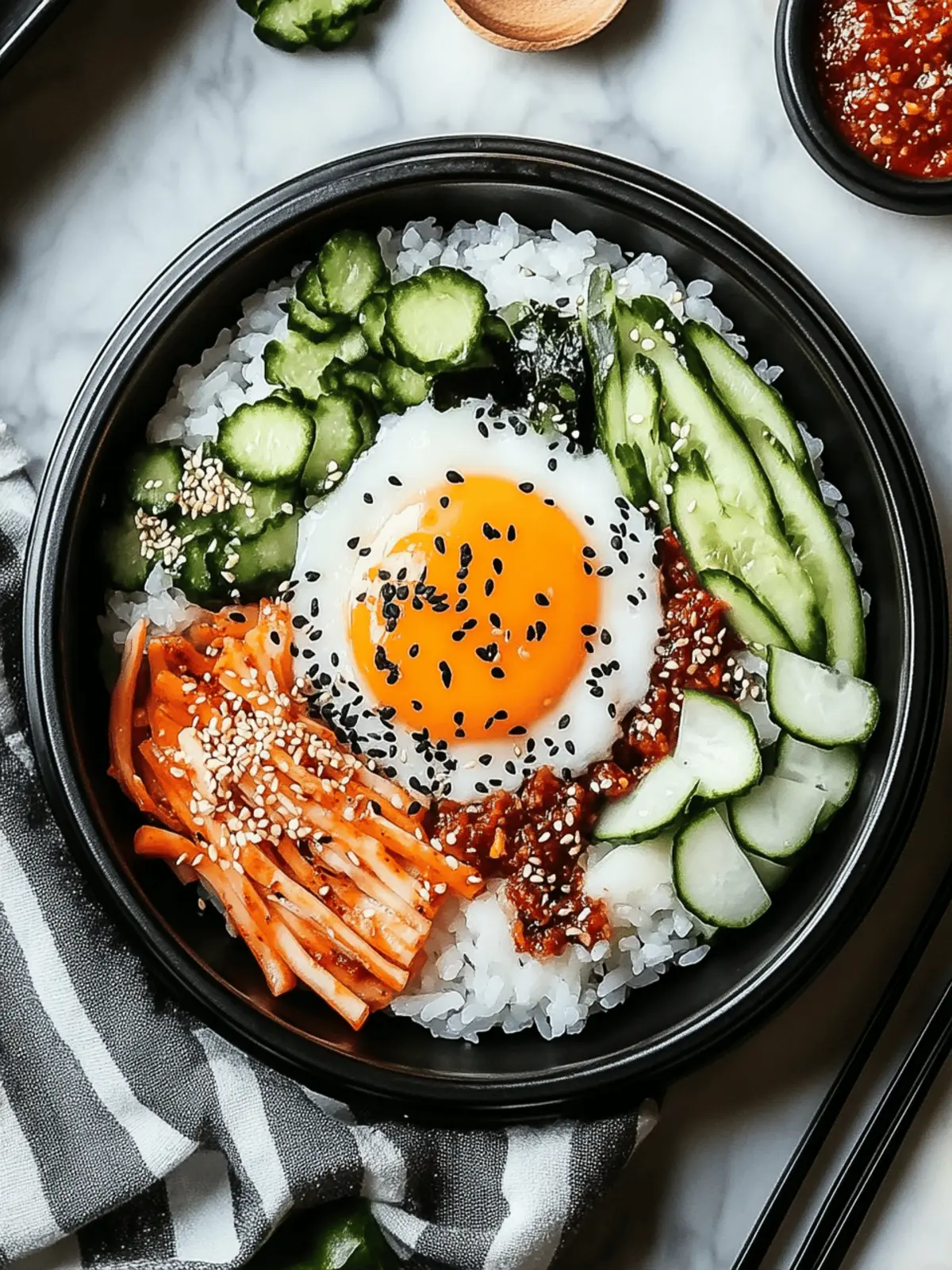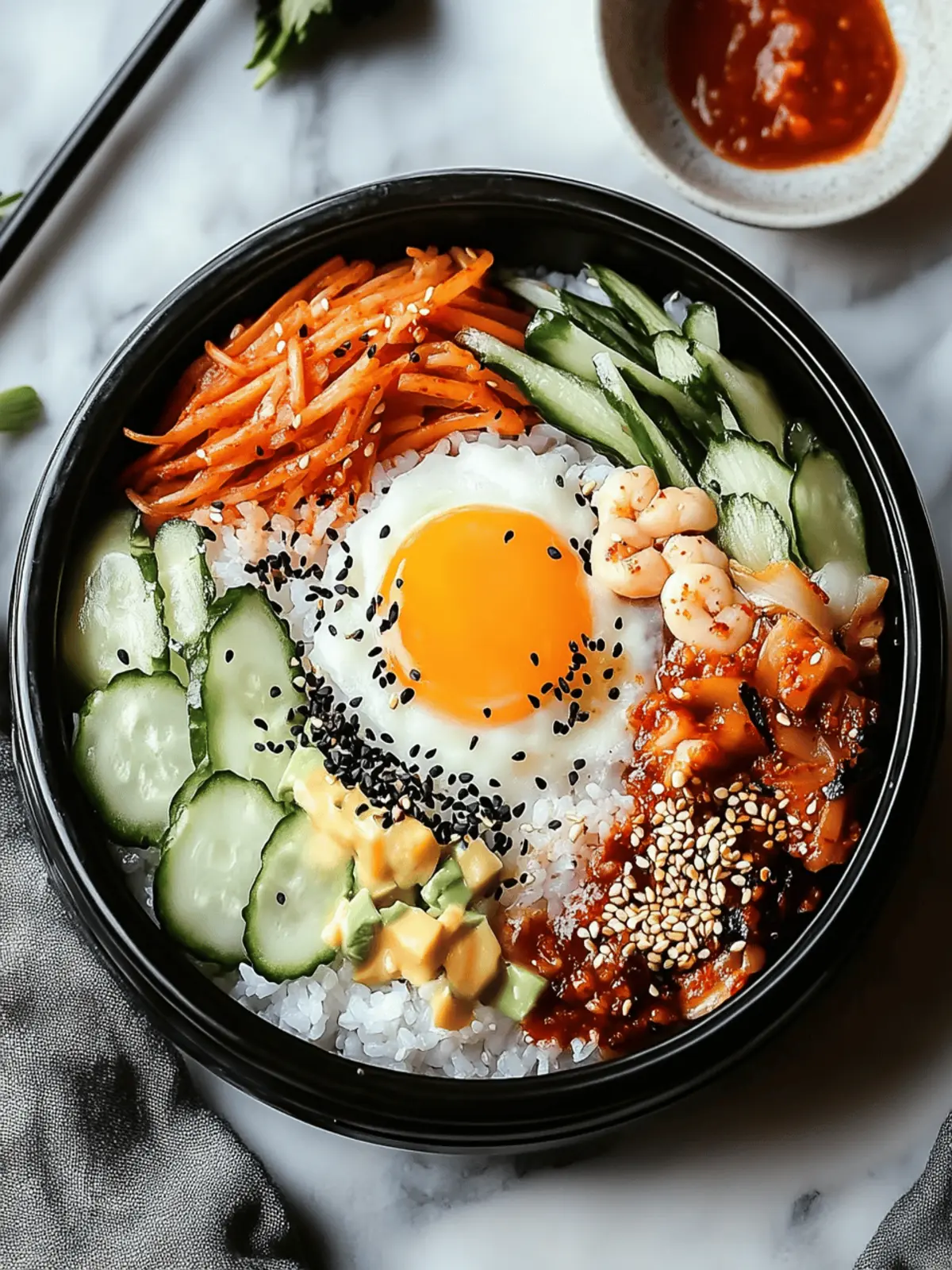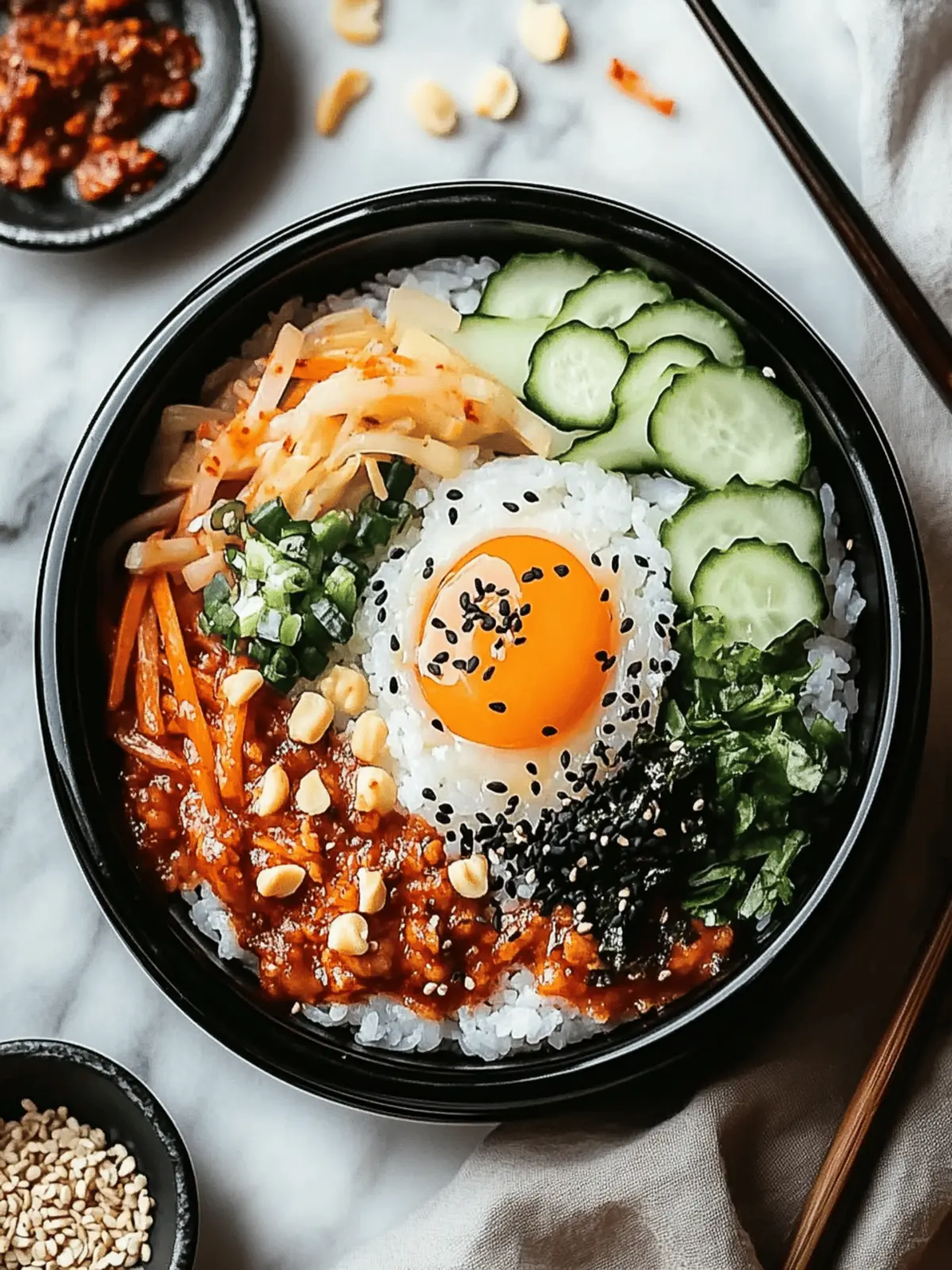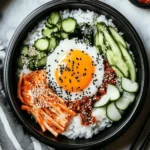There’s something soul-soothing about the vibrant colors and flavors of Korean Bibimbap that brings me joy, especially on a chilly evening. As the warm, crispy rice meets a rainbow of sautéed vegetables and a perfectly fried egg, I can’t help but feel an instant connection to the heart of Korean cuisine. This dish embodies harmony, effortlessly combining savory, spicy, and fresh elements that cater to any palate, whether you’re diving into a comforting bowl after a hectic day or impressing friends at a dinner party.
When I first tried making Bibimbap at home, I was surprised at how easily I could incorporate seasonal veggies and substitute proteins, making it not only versatile but also a reflection of my own culinary creativity. The spiced gochujang sauce pulls everything together, creating a delightful balance that transforms even simple ingredients into an extraordinary meal. Join me as we explore this iconic dish that celebrates delicious, homemade comfort and showcases the beauty of assembly at its finest!
Why is Korean Bibimbap a Must-Try Dish?
Vibrant Colors: This dish is a feast for the eyes, boasting a beautiful array of fresh vegetables that make each bowl a work of art.
Customizable: With endless options for vegetables and proteins, you can easily create a version that suits your taste and dietary needs, whether you’re a meat lover or a vegan.
Flavor Harmony: The delightful blend of savory, spicy, and tangy elements makes each bite burst with flavor, while the crispy rice adds an irresistible crunch.
Quick and Easy: Perfect for weeknight dinners, this recipe can be whipped up in under 30 minutes, allowing you to enjoy a homemade meal without the fuss.
Cultural Experience: Making Korean Bibimbap at home brings a taste of authentic Korean cuisine to your kitchen, deepening your appreciation for diverse culinary traditions.
Crowd-Pleaser: Whether hosting friends or enjoying a family meal, this dish is sure to impress, making it a go-to for gatherings or even casual dinners.
Korean Bibimbap Ingredients
For the Rice Base
• Short-grain White Rice – This provides the ideal sticky texture for your bibimbap, ensuring a satisfying bite.
For the Vegetables
• Spinach – Blanch briefly to preserve vibrant color and nutrients before adding it to your bowl.
• Bean Sprouts – Quick blanching enhances their crunchiness, making them a delightful addition.
• Shiitake Mushrooms – Offers an earthy flavor, but feel free to swap with whatever mushrooms you prefer.
• Carrots – Julienned to cook quickly while adding a sweet flavor profile.
• Cucumber – Adding freshness, julienned for the perfect crunch.
For the Protein
• Large Eggs – Fry sunny-side up for a rich topping; you can use scrambled tofu as a vegan alternative.
• Cooked Beef (optional) – Adds protein and heartiness; easily omit for a vegetarian version.
For the Sauce
• Gochujang (Korean red pepper paste) – Essential for authentic flavor; adjust according to your heat preference.
• Soy Sauce – Provides umami; choose low-sodium if you’re watching your salt intake.
• Minced Garlic – Enhances the aromatic profile of the sauce.
• Sugar – Balances the flavors, complementing the and spicy elements wonderfully.
• Rice Vinegar – Adds a tangy kick that brightens up the sauce.
• Olive Oil – Used for mixing into the sauce; can substitute with other oils if desired.
• Sesame Oil – Brings a nutty aroma to the dish, elevating its overall flavor.
For the Garnish
• Sesame Seeds – Toasted seeds add a lovely crunch and nutty goodness.
How to Make Korean Bibimbap
- Heat sesame oil in a medium pan over medium heat. Stir-fry the cooked rice for 2-3 minutes until it’s lightly crispy, creating a delightful texture for your bibimbap.
- Set aside the crispy rice in a bowl, then use the same pan, adding vegetable oil to cook the vegetables. This way, you capture all the delicious flavors.
- Sauté sliced shiitake mushrooms with minced garlic in the pan for about 4-5 minutes, until they become soft and fragrant, enhancing your dish with an earthy depth.
- Blanch spinach and bean sprouts in boiling water for just 1 minute, then quickly drain them. This brings out their vibrant colors while keeping that satisfying crunch.
- Julienne the carrots and cucumber, setting them aside for later. This quick prep ensures that they maintain their fresh texture and are easy to assemble.
- Combine gochujang, soy sauce, rice vinegar, sesame seeds, sugar, and olive oil in a bowl. Mix until well incorporated for a spicy-sweet sauce that will tie all flavors together perfectly.
- Assemble your bibimbap by placing the crispy rice at the base of a bowl. Neatly arrange the sautéed mushrooms, blanched vegetables, and optional cooked beef around the rice.
- Top each bowl with a fried egg, allowing the yolk to shine when served. Drizzle the homemade sauce generously over the top and enjoy this vibrant dish immediately!
Optional: Garnish with fresh herbs or additional sesame seeds for an extra touch of flavor.
Exact quantities are listed in the recipe card below.
Korean Bibimbap Variations
Feel free to get creative with your Korean Bibimbap – customization is what makes this dish so special!
- Vegetarian Delight: Replace beef with marinated tofu or tempeh for a satisfying plant-based protein that pairs beautifully with the vegetables.
- Extra Crunch: Toss in some roasted peanuts or crushed nuts for an added layer of crunch and richness that takes each bite to new heights.
- Seasonal Swap: Use seasonal vegetables like zucchini, bell peppers, or even sweet potato to keep your bibimbap fresh and exciting with each season.
- Spicy Kick: If you love heat, spice things up by adding minced fresh chili or a dollop of kimchi on top for an exciting twist.
- Herbed Up: Sprinkle in fresh herbs like cilantro or green onions, enhancing the dish with fragrant notes that brighten the overall flavor.
- Umami Boost: A dash of fish sauce or a sprinkle of dried seaweed can elevate the umami profile, perfect for those who enjoy robust flavors.
- Crispy Toppings: Add a crispy fried onion or garlic topping for a delightful crunchy texture that complements the soft veggies and rice.
- Sweet Twist: For a unique contrast, include thinly sliced pickled radish or a touch of hoisin sauce for a hint of sweetness that balances the spicy gochujang.
How to Store and Freeze Korean Bibimbap
Fridge: Store the assembled bibimbap in an airtight container in the refrigerator for up to 3 days. Keep the sauce separate to maintain the freshness of the ingredients.
Freezer: For longer storage, freeze the rice and vegetables in separate portions for up to 1 month. This allows you to enjoy homemade Korean Bibimbap at a later time with just a quick reheat.
Reheating: When you’re ready to enjoy, thaw the rice and veggies in the fridge overnight, then reheat them in a pan or microwave until hot. Fry a fresh egg for the topping to regain that delicious texture.
Prep Ahead: Prepping ingredients like the vegetables and sauce in advance keeps your Korean Bibimbap fresh and flavorful, ensuring a quick and satisfying meal when you’re ready to serve.
Make Ahead Options
Korean Bibimbap is perfect for meal prep, allowing busy cooks to savor its delightful flavors any day of the week! You can prepare your vegetables, such as blanched spinach, bean sprouts, carrots, and sautéed mushrooms, up to 3 days in advance. Store them separately in airtight containers in the refrigerator to maintain their texture and freshness. The rice can also be made ahead and reheated; it keeps well for up to 24 hours when stored in the fridge. When you’re ready to enjoy your bibimbap, simply reheat the rice and topped components, fry an egg (or tofu), and assemble everything in a bowl with the gochujang sauce right before serving for a meal that’s just as delicious as freshly made!
Expert Tips for Korean Bibimbap
- Use Leftover Rice: Cold, day-old rice works best as it maintains its texture and prevents sogginess when stir-fried. Freshly cooked rice can become mushy.
- Prep Veggies First: Have all your vegetables ready before cooking the egg. This keeps the prep flow smooth and ensures everything is served hot.
- Adjust Gochujang: If you’re unsure about heat levels, start with a smaller amount of gochujang. You can always add more later to suit your taste.
- Don’t Overcook Veggies: Quick blanching or sautéing allows the colors and textures of the vegetables to shine. Overcooked veg can lose their crunch and vibrant appeal.
- Experiment with Proteins: Feel free to swap out the beef for tofu, tempeh, or even chickpeas for a hearty vegetarian version of your Korean Bibimbap.
What to Serve with Korean Bibimbap?
Elevate your meal experience with delightful pairings that complement the vibrant flavors of your bibimbap.
- Kimchi: This fermented side adds a spicy, sour crunch, enhancing the overall flavor profile of bibimbap.
- Sesame Kale Salad: The light, nutty flavor of sesame combined with fresh kale brings crispness that balances the warm bowl.
- Miso Soup: A warm, umami-rich soup that gently contrasts with the bold spices of bibimbap, creating a comforting combination.
- Cucumber Pickles: Sweet and tangy cucumber pickles offer a refreshing bite that complements the savory ingredients beautifully, adding a delightful crunch.
- Sweet Potato Fries: Slightly sweet and crispy, these fries provide a comforting texture that pairs well with the tender vegetables in bibimbap.
- Barley Tea: Chilled or warm, this nutty beverage cleanses the palate, allowing each spoonful of bibimbap to shine brightly.
- Steamed Dumplings: These savory bites can be filled with vegetables or meat, adding a different texture and flavor that harmonizes with your meal.
- Fresh Grapes: For a unique twist, serve a bowl of sweet grapes for dessert. Their juiciness provides a refreshing end after enjoying the flavorful bibimbap.
Korean Bibimbap Recipe FAQs
How do I choose ripe vegetables for my Korean Bibimbap?
Absolutely! For your bibimbap, opt for vibrant and fresh vegetables. Look for spinach that’s deep green without wilting, carrots that are firm and unblemished, and mushrooms that are plump and fragrant. Cucumbers should have a shiny skin, while bean sprouts should be crisp without any dark spots. Whole ingredients guarantee that your dish shines with fresh flavors!
How should I store leftover Korean Bibimbap?
Very! If you’re storing leftover Korean Bibimbap, place the assembled dish in an airtight container in the refrigerator for up to 3 days. To keep the ingredients fresh, consider separating the sauce from the rest of the bowl. This way, you maintain the texture of the veggies and prevent sogginess in the rice.
Advertisement
Can I freeze my Korean Bibimbap?
Yes, indeed! To freeze your Korean Bibimbap, prepare and cool the rice and vegetables completely, then portion them into airtight freezer bags. They can be stored frozen for up to 1 month. When you’re ready to enjoy, thaw them overnight in the fridge, then reheat in the microwave or pan. Fry a fresh egg to top it off before serving for that delicious finish!
What if my vegetables overcook while making Bibimbap?
Oh no! If you find that your veggies have overcooked, don’t fret! To correct this, gently sauté them in a bit of oil to revive some crunch or brighten their appearance with a splash of cold water. For best results, keep an eye on cook times; aim for quick blanching or sautéing to preserve their vibrant colors and delightful textures.
Can I make a vegan version of Korean Bibimbap?
Of course! To create a delicious vegan Korean Bibimbap, simply swap the fried egg for scrambled tofu or an alternative like avocado for creaminess. Everything else remains the same—your vibrant mix of veggies, rice, and your flavorful gochujang sauce makes this dish just as delightful without animal products.
How long can I keep the sauce for my Bibimbap?
Great question! You can store the bibimbap sauce in an airtight container in the fridge for up to 2 weeks. Just be sure to give it a good stir before using as the ingredients may settle. This sauce brings flavor to your dish even after it’s been made, allowing you to enjoy the essence of Korean cuisine whenever you wish!

Korean Bibimbap: A Wholesome Bowl of Vibrant Flavors
Ingredients
Equipment
Method
- Heat sesame oil in a medium pan over medium heat. Stir-fry the cooked rice for 2-3 minutes until it’s lightly crispy.
- Set aside the crispy rice in a bowl, then use the same pan to cook the vegetables with vegetable oil.
- Sauté sliced shiitake mushrooms with minced garlic for about 4-5 minutes until soft.
- Blanch spinach and bean sprouts in boiling water for 1 minute, then drain.
- Julienne the carrots and cucumber, setting them aside for later.
- Combine gochujang, soy sauce, rice vinegar, sesame seeds, sugar, and olive oil in a bowl and mix well.
- Assemble your bibimbap by placing the crispy rice at the base of a bowl and arranging the vegetables and optional beef around it.
- Top each bowl with a fried egg and drizzle the homemade sauce over the top.








